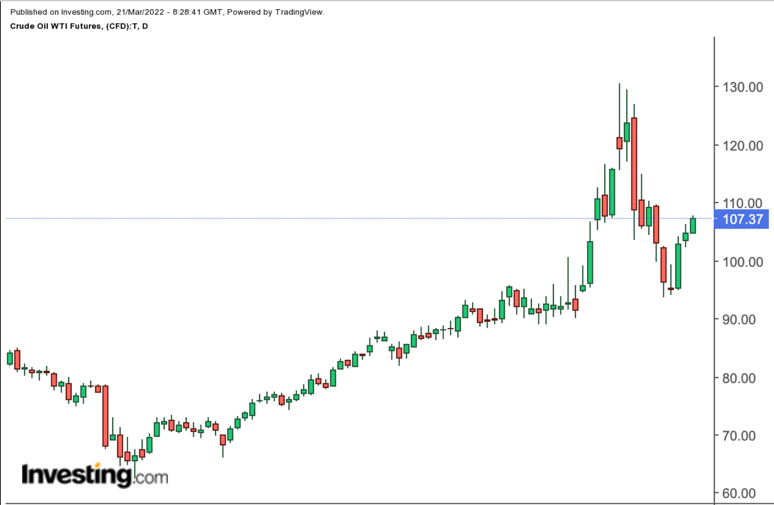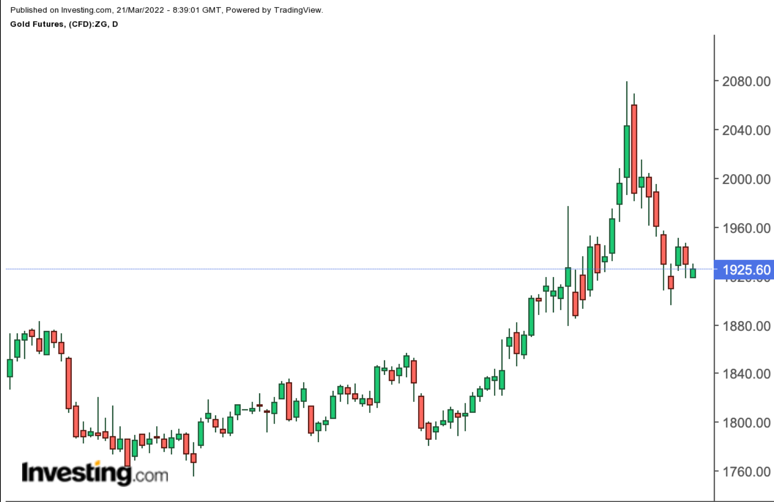With the Fed’s long-awaited rate hike out of the way and bombs raining again on Ukraine, what do commodity investors do? Chase up prices, that’s what—at least oil prices.

Crude prices jumped 3% in Monday’s Asian trading, adding to last week’s gain of around 4%. Oil’s latest fervor came amid a fresh spike in geopolitical tensions as Ukrainian forces dug in against heavy Russian attacks.
Crude also got a fundamental boost as major oil producers in OPEC+ reported they were struggling to produce quotas allotted under their supply agreement.
The 13-member Saudi-led Organization of the Petroleum Exporting Countries (OPEC), along with 10 oil producers steered by Russia under the broader OPEC+ alliance, deliberately starved the market of supply for months to push prices up multifold from the pandemic’s lows. They now say that almost two years of zero or little investments on production since the COVID outbreak was hampering their effort to turn out more barrels.
London-traded Brent, the global benchmark for oil, was up $3.19, or 3%, at $111.12 a barrel by 3:15 PM in Singapore (3:15 AM in New York). Brent lost almost 9% over the past two weeks.
US crude’s West Texas Intermediate (WTI) benchmark was up $3.41, or 3.3%, at $106.50 a barrel. Like Brent, WTI was down about 9% over the past two weeks.
If WTI holds above $109.33 in this week’s trade, it could reach $111.50, said Sunil Kumar Dixit, chief technical strategist at skcharting.com. “Breaking and sustaining above $109.33 is essential to reach $111.50 and eventually $116,” he added.
“We are now awaiting geopolitical developments,” said Jeffrey Halley, Asia-Pacific analyst at online trading platform OANDA.
“Even if the Ukraine war ends tomorrow, the world will face a structural energy deficit, thanks to Russian sanctions.”
Halley added:
“We are now awaiting geopolitical developments. Although I don’t rule out a test below $100 on a Ukraine agreement, I believe that any dip to the low $90.00’s by oil will be very well supported.”
Ukraine's deputy prime minister, Iryna Vershchuk said early on Monday there was no chance that the country's forces would surrender in the besieged eastern port city of Mariupol.
With little sign of the conflict easing, the focus returned to whether the market would be able to replace Russian barrels hit by sanctions.
"The market continues to fret about supply disruptions, with data suggesting they are already impacting," ANZ analysts said in a note.
OPEC+ missed its production target by more than 1 million barrels daily in February, Reuters quoted three sources at the alliance as saying. Under their pact, the 23 producers were supposed to boost output by 400,000 bpd each month as they wind back sharp cuts made in 2020.
The two OPEC countries that have the capacity to instantly raise output—Saudi Arabia and the United Arab Emirates—are continuing to milk the situation for what it’s worth.
Despite the run-up in oil and a broad number of other commodities, prices of gold barely moved, trading a touch lower from Friday’s close.
The most-active gold futures contract on New York’s COMEX, April, was down $4.65, or 0.2%, at $1,924.65 an ounce. Last week, the benchmark gold futures contract lost 2.8%, its most since the week to Nov. 19.
“Weakness below $1,920 may push gold down to $1,907, below which bears may gain extra strength causing more dents to the metal and $1,895 can give way, exposing $1,845-$1,820 over the upcoming week,” said Dixit.
Halley of OANDA said risk markets were “pricing in the worst of the Fed being out of the way, and expectations of progress in a resolution of the Ukraine-Russia conflict,” although he conceded that “both could yet come back to bite.”
Market watchers will continue to monitor the course of the war in Ukraine and headlines could continue to cause market turbulence in the upcoming week. Diplomacy efforts are ongoing even as Russian strikes on Ukrainian cities continue.
US President Joseph Biden is to join a NATO meeting on Wednesday and also a mid-week EU summit in Brussels, aiming to cement the new-found cohesiveness with European allies. The West is risking rifts with China and India, which have not condemned Russia’s invasion of Ukraine.
On Friday, Biden warned his Chinese counterpart, Xi Jinping, of "consequences" if Beijing gave material support to Russia's invasion of Ukraine.
China has not condemned Russia's actions, though it has expressed concern about the war. Chinese Vice Foreign Minister Le Yucheng said on Saturday that Western sanctions against Russia were "outrageous."
The Federal Reserve approved last week a 25-basis point increase at its Mar. 15-16 meeting, its first increase since the outbreak of the COVID-19 crisis in March 2020. The central bank also cautioned that there could be as many as six more rate hikes this year, based on the number of calendar meetings for its policy-making Federal Open Market Committee (FOMC).
Following through with the Wednesday rate decision, Fed Governor Christopher Waller—one of the more hawkish members of the FOMC—said US economic data is “screaming” for bigger half percentage point rate hikes in coming months to stamp out inflation.
Fed Chairman Jerome Powell reiterated after this week’s rate increase that the central bank will be “nimble” as it tries to balance the fastest economic growth in nearly four decades with inflation, also growing at its most frenetic pace in 40 years. US gross domestic product was up 5.7% last year after a 3.5% contraction in 2020, growing at its most since 1984. Inflation, measured by the Consumer Price Index (CPI), expanded by 5.8% in 2021, its most since 1982. The Fed’s own tolerance for inflation is just 2%.
Waller, who has consistently pushed for tighter monetary policy and higher fiscal discipline to tame inflation, said the risks from the Ukraine war led him to support more dovish colleagues on the FOMC in voting for a subdued rate hike at the March meeting.
But he said he might push for a series of 50-basis point increases at coming FOMC meetings to "front load" a tighter policy that would have a greater impact in tamping down inflation.
"Going forward that will be an issue—about going 50—in the next couple of meetings,” Waller said, anticipating resistance from other FOMC members.
“But the data is suggesting we move in that direction. I really favor frontloading our rate hikes. (Let’s) just do it, rather than just promise it.”
Fed Chair Jerome Powell is scheduled to speak on Monday about the economic outlook at the annual conference of the National Association for Business Economics, less than a week after the Fed kicked off what is expected to be an aggressive monetary policy tightening cycle.
On Wednesday, Powell is to participate in a virtual panel discussion at a summit hosted by the Bank for International Settlements.
Several other Fed officials are also due to make speeches during the week, including New York Fed President John Williams, San Francisco Fed President Mary Daly, Cleveland Fed President Loretta Mester, Minneapolis Fed President Neel Kashkari, Fed Governor Christopher Waller and Chicago Fed President Charles Evans.
Disclaimer: Barani Krishnan uses a range of views outside his own to bring diversity to his analysis of any market. For neutrality, he sometimes presents contrarian views and market variables. He does not hold positions in the commodities and securities he writes about.
